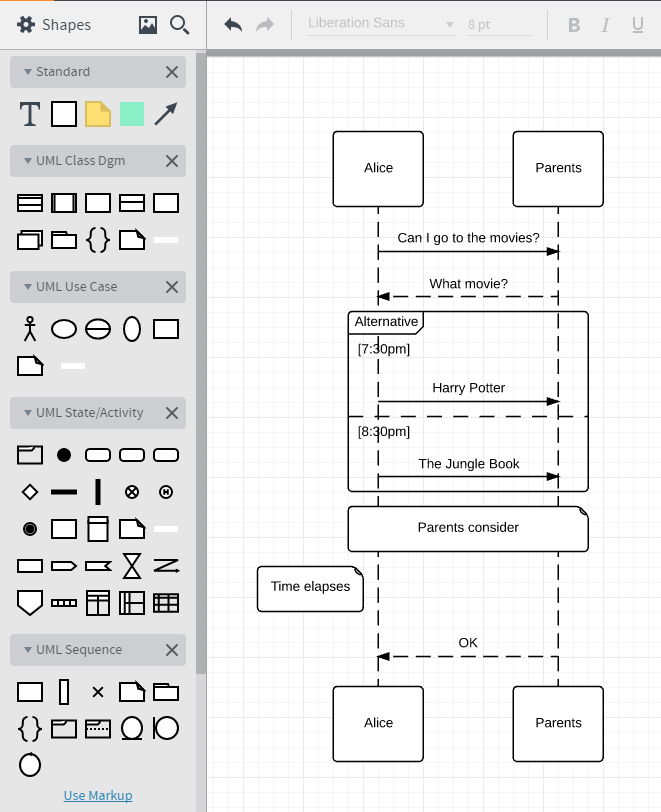UML Sequence Diagrams Made Easy
Lucidchart’s UML Sequence Markup allows users to rapidly create the sequence diagram they need using a simple markup language
Join the DZone community and get the full member experience.
Join For FreeHere at Lucid Software, we are all about simplifying processes. Our goal is to discover new ways to make your life easier, which is why we’re excited to introduce our UML Sequence Markup feature—aka your one stop for beautiful sequence diagrams created faster with less hassle.
Gone are the days of dragging and dropping each shape to piece together a diagram. This premium tool allows you to generate a UML sequence diagram simply by typing your markup directly into Lucidchart:
- Create a new Lucidchart document.
- Click “More Shapes”.
- Open the UML shapes library.
- Select the “Use Markup” button in the UML Sequence category.
- Enter your markup in the pop-up dialog that appears. As soon as you click “OK,” the magic happens, generating a sequence diagram that follows industry standards for UML markup.
It’s intuitive, it’s easy, and it’s fast. You’re able to spend less time trying to create your diagram and more time actually using it.
“When I use Lucidchart, I’m trying to get a job done as quickly as possible. Our new UML sequence markup tool gets me to a great diagram faster, and I’m thrilled to share this time-saving feature with our users. It frees up resources to improve efficiency overall,” said Ben Dilts, our co-founder and chief technology officer here at Lucid Software.
While other tools may perform a similar function, Lucidchart stands out in more ways than one—we’ve managed to narrow it down to our top three.
- Lucidchart allows you to re-edit the markup to update a diagram that is on the page. Your diagrams are living documents allowing you to continually refine your creations. Simply click the “Use Markup” button again to add to or edit your markup. When you do so, the spacing is automatically adjusted for a clean and professional feel.
- Once your sequence diagram is created, it can be customized with just a few clicks. With complete access to all Lucidchart’s easy-to-use formatting capabilities, you can make your diagram fit your every specification. Pick your theme. Style your lines. Choose your text.
- Lucidchart lets you pick and choose your diagramming style. If you’re designing a larger UML sequence diagram that will require constant updating, use markup. If you’re building a simple diagram, feel free to drag and drop shapes from our complete UML library. Or make it a combo deal—get your diagram started with markup and then edit by dragging and dropping. It’s diagramming done your way to fit your needs.
“Lucidchart’s UML Sequence Markup allows users to rapidly create the sequence diagram they need using a simple markup language,” said Brian Pugh, vice president of engineering at Lucid Software. “Then they can take advantage of the full power of Lucidchart’s editing tools to customize the diagram as needed. In short, it allows users to efficiently create visually stunning diagrams.”
Chances are you’re not the only one who’ll be using this diagram, and one of the keys to effective diagramming is collaboration. Once you’ve got your diagram just the way you want it, share it with your colleagues. You’ll be able to choose whether they can view, edit, comment or share the document. Use Lucidchart’s chat feature to collaborate in real time or even start a Google Hangout—all from within your document. Don’t worry about compatibility, as the UML Sequence Markup tool works on every major Internet browser and Internet-enabled device.
Don’t just take our word for it. Check out this comment from one of our users, “I LOVE the new UML Sequence Markup feature! The ability to create/edit diagrams using simple markup is one of the most important features for me. I’d love to see more markup-based diagrams!”
Learn more about our UML Sequence Markup editor and explore Lucidchart’s UML tool.
Published at DZone with permission of Jacob Shumway. See the original article here.
Opinions expressed by DZone contributors are their own.



Comments